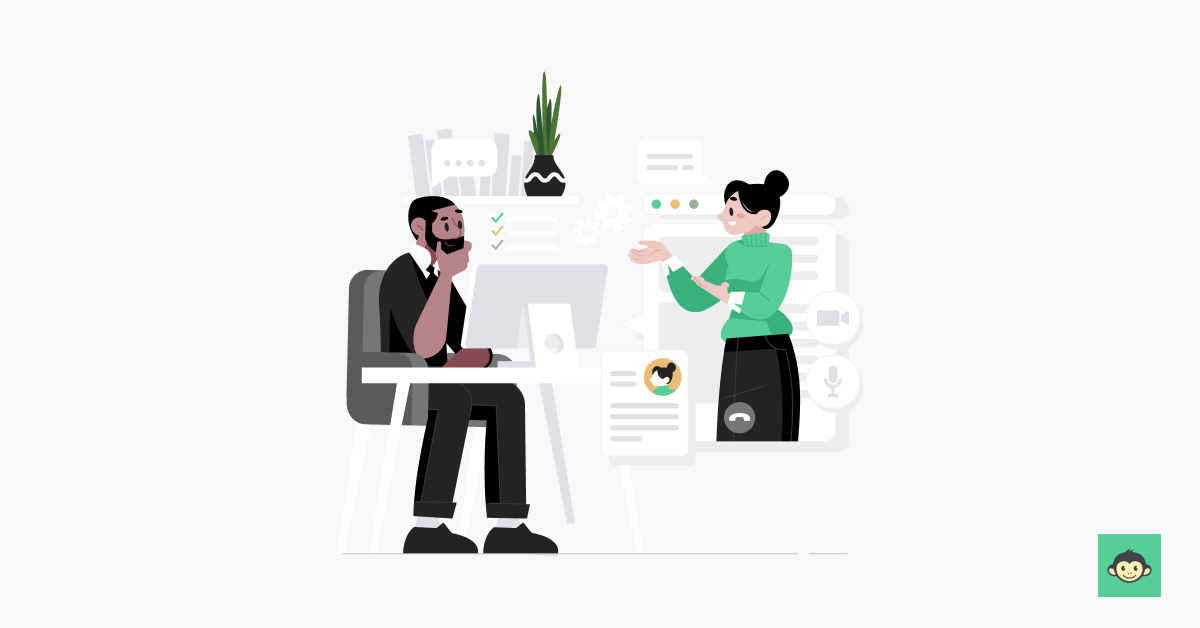Employee listening: How does continuous listening positively impact retention in 2024?

Wondering why your workplace is buzzing with whispers and not just the coffee machine? That's the sweet sound of an employee listening to hitting a crescendo in 2024!
In this era of high-tech gossip, we're decoding the secrets of continuous employee listening—more than just eavesdropping on water cooler convos. It's the strategy behind a whopping 87% of employees believing in the power of active listening which turns the workplace into talent magnets.
So, grab your metaphorical spyglass and join us on this journey through the symphony of continuous listening, where every engaged employee is a note in the chart-topping song of retention success. Let the eavesdropping begin!
What is an employee listening to at work?
Employee listening at work is a strategic approach employed by organizations to actively engage with and understand the concerns, feedback, and sentiments of their employees. It goes beyond traditional methods of communication and emphasizes creating a culture where employees feel heard, valued, and empowered to voice their opinions.
This involves utilizing various channels, such as surveys, feedback sessions, town hall meetings, and digital platforms, to capture the diverse perspectives of the workforce. Employee listening aims to foster a transparent and inclusive environment, enabling organizations to address issues promptly, enhance employee satisfaction, and make informed decisions that align with the needs and aspirations of their workforce.
Successful implementation of employee listening initiatives can contribute to improved employee morale, increased productivity, and a positive organizational culture.
What are the benefits of employee listening?

Employee listening goes beyond just hearing what they have to say; it's about understanding, valuing, and acting upon their feedback. Here are six distinctive benefits:
- Cultivating innovation orchards: When employees feel heard, they're more likely to share innovative ideas freely. It's like planting seeds in a well-tended garden; their ideas sprout, leading to groundbreaking innovations that drive the company forward.
- Harmonizing the symphony of talent: Listening to employees nurtures a culture of inclusivity, where every voice adds to the symphony. Diverse perspectives create a vibrant orchestra, resulting in better problem-solving and richer creativity.
- Fortifying the retention fortress: Employees who feel listened to are more likely to stick around. It's the fortress of retention—fostered by a sense of belonging and appreciation, reducing turnover and saving the kingdom from the costly dragon of recruitment.
- Fueling engagement rockets: Listening creates an emotional connection. Engaged employees become rocket fuel for productivity, morale, and customer satisfaction. They're not just working; they're soaring with passion and purpose.
- Crafting custom-made solutions: Employee insights act as a tailor's tape, creating bespoke solutions. Their input guides HR policies, benefits, and work processes, ensuring they fit like a perfectly tailored suit, rather than an off-the-rack solution.
- Seeding a culture of trust: Listening is the fertile soil where trust grows. Trust cultivates open communication, transparency, and mutual respect, establishing a sturdy foundation for a positive and healthy workplace culture.
Employee listening isn't merely about ticking boxes; it's the art of nurturing a thriving ecosystem where every employee feels valued, understood, and empowered. In return, organizations reap a bountiful harvest of innovation, loyalty, and success.
5 Employee listening best practices you should know
Effective employee listening is more than just hearing words; it's about understanding, valuing, and responding to employee perspectives. Here are five best practices to cultivate a culture of active employee listening programs in the workplace:
- Regular surveys and feedback mechanisms: Implement periodic surveys to gather feedback on various aspects of the work environment. This can include satisfaction surveys, pulse checks, and open-ended questions. Use the insights gained from the pulse survey to identify areas of improvement and showcase a commitment to continuous growth.
- Anonymous channels for honest expression: Create platforms where employees can express their opinions anonymously. Anonymous suggestion boxes, online forums, or confidential employee surveys can encourage honest feedback, providing employees with a safe space to share concerns or suggestions without fear of reprisal.
- Active listening training for managers: Equip managers with active listening skills through training programs. This involves not just hearing words but understanding the underlying emotions and concerns. Training sessions can include role-playing scenarios and techniques to implement employee listening strategies that enhance empathy and engagement.
- Open forums: Organize regular town hall meetings or open forums where leadership communicates updates, and employees have the opportunity to voice their thoughts. Encourage an open dialogue, and ensure that employees feel heard by addressing their queries and concerns during these sessions.
- Personalized development plans: Engage in one-on-one discussions with employees to understand their career goals, aspirations, and challenges. Create personalized development plans based on their feedback, showing a commitment to their professional growth. This not only demonstrates that their input matters but also fosters a sense of value and investment in their success.
Incorporating these employee listening best practices into the organizational culture fosters a sense of transparency, trust, and inclusivity. Actively listening to employees not only enhances their experience but also contributes to a more productive and harmonious workplace.
Why should you be very strategic about your employee listening approach?

Being strategic about your employee listening approach is crucial for fostering a healthy workplace culture and maximizing organizational success. A well-thought-out strategy ensures that collected feedback aligns with business goals, enabling leaders to make informed decisions.
Strategic employee listening goes beyond sporadic surveys; it involves creating a continuous, two-way communication channel that builds trust and empowers employees to share their insights. By understanding employee concerns, aspirations, and engagement levels, organizations can address issues proactively, enhance employee satisfaction, and reduce turnover.
Moreover, a strategic approach allows for the identification of patterns and trends over time, enabling the implementation of targeted interventions that positively impact both employee morale and overall organizational performance.
In essence, a thoughtful employee listening strategy serves as a compass, guiding organizations toward a more engaged, productive, and harmonious work environment.
What are employee listening programs and how to implement them?

Employee Listening Programs (ELPs) are strategic initiatives designed to gather, analyze, and act upon feedback from employees. These programs aim to create a culture of open communication, foster employee engagement, and address concerns that impact workplace satisfaction.
By using engagement surveys and actively listening to the workforce, organizations gain valuable insights, enhance employee morale, and contribute to a positive work environment.
Steps to implement employee listening programs:
Leadership commitment:
- Secure commitment from leadership to prioritize employee feedback.
- Demonstrate the value of ELPs in driving organizational success.
Define objectives:
- Clearly outline the goals of the program.
- Align objectives with broader organizational strategies.
Choose appropriate tools:
- Select survey and feedback tools that suit the organization's size and structure.
- Ensure platforms allow for anonymity if needed.
Communication strategy:
- Communicate the purpose and benefits of the program transparently.
- Encourage participation and assure confidentiality.
Training and support:
- Provide training for managers on interpreting and acting on feedback.
- Establish support mechanisms for employees expressing concerns.
Feedback analysis and action planning:
- Regularly analyze feedback data to identify trends.
- Develop action plans to address identified issues and celebrate successes.
Continuous improvement:
- Iterate on the program based on feedback from employees.
- Showcase improvements resulting from employee input.
Implementing Employee Listening Programs is a proactive step toward creating a workplace where employees feel valued, heard, and motivated to contribute to the organization's success.
What are the channels of employee listening?

Employee listening is a crucial aspect of creating a positive work environment and fostering employee engagement. Organizations employ various channels to effectively listen to their employees. Here are some prominent channels:
- Surveys and questionnaires: Traditional surveys and questionnaires are a common method. They cover a range of topics, from job satisfaction to organizational culture, providing quantitative and qualitative data.
- Feedback sessions and town halls: Interactive sessions, whether in-person or virtual, allow employees to share their thoughts, concerns, and suggestions directly with leadership. Town hall meetings create an open forum for transparent communication.
- Focus groups: Small employees engage in detailed discussions on specific topics. This qualitative approach allows for in-depth exploration of ideas and concerns.
- One-on-one meetings: Regular individual check-ins between employees and their supervisors provide a personal space for concerns, career development, and feedback. This personalized approach can build trust and strengthen relationships.
- Employee resource groups (ERGs): ERGs, also known as affinity groups, bring together employees with shared characteristics or interests. They provide a platform for open conversations and help organizations understand diverse perspectives.
- Social media and intranet platforms: Organizations leverage internal platforms for open forums and discussions. Social media and intranet channels facilitate real-time feedback and create a sense of community.
- Exit interviews: Conducted when an employee leaves, exit interviews gather insights into the employee's experiences and reasons for departure, offering valuable feedback for organizational improvement.
- Pulse surveys: Short, frequent surveys provide real-time insights into business leaders and employee sentiments. They are quick and easy, and help organizations stay agile in addressing immediate concerns.
- Suggestion boxes: Though traditional, suggestion boxes remain effective. They allow employees to submit anonymous feedback, ensuring confidentiality and encouraging candid responses.
- Digital communication platforms: Chat channels, email, and other digital communication tools enable continuous, informal communication, allowing employees to express themselves on an ongoing basis.
By utilizing a combination of these channels, organizations can establish a comprehensive employee listening strategy, demonstrating a commitment to understanding and addressing the needs of their workforce.
What is an employee listening strategy?
An employee listening strategy refers to a systematic approach employed by organizations to actively gather, analyze, and respond to the feedback and concerns of their workforce.
It goes beyond traditional methods of employee feedback by incorporating various channels, such as surveys, focus groups, town hall meetings, and digital platforms, to create an inclusive and continuous feedback loop.
The strategy aims to foster a culture of open communication, engagement, and collaboration, enabling organizations to better understand the needs, sentiments, and expectations of their employees.
By implementing an effective employee listening strategy, organizations can identify areas for improvement, address concerns promptly, enhance employee satisfaction, and ultimately contribute to a more positive and productive work environment.
This approach aligns with the evolving dynamics of the modern workplace, emphasizing the importance of actively valuing and incorporating the voices of employees into organizational decision-making processes.
How to build a successful employee listening strategy?

Building a successful employee listening strategy is an ongoing process. Regularly assess the effectiveness of the employee listening tool and your methods, adjust as needed, and showcase the positive changes that result from employee feedback to foster a culture of continuous improvement.
Surveys with a purpose
Create targeted surveys that delve into specific aspects of the employee experience. Don't just ask generic questions; tailor surveys to gather insights on engagement, workplace culture, and areas needing improvement.
Include a mix of quantitative and qualitative questions to capture nuanced feedback. Analyze the data transparently and implement changes based on the results, demonstrating a commitment to action.
Anonymous feedback channels
Establish anonymous communication channels to encourage honest and uninhibited feedback. This could be through suggestion boxes, anonymous online forums, or dedicated email addresses.
Anonymity fosters openness, allowing employees to express concerns or suggestions without fear of reprisal. Regularly review and respond to the feedback received, ensuring employees feel heard and valued.
Continuous pulse checks
Implement regular, short pulse surveys to keep your finger on the organizational pulse. These quick check-ins provide real-time insights into employee sentiments, allowing for swift adjustments.
Choose a variety of topics, from workload to team dynamics, ensuring that you are capturing a holistic view of the employee experience. Act on the feedback promptly to showcase responsiveness and dedication to improvement.
Focus group dialogues
Organize focus group discussions to dive deeper into specific topics. These sessions provide a platform for in-depth conversations, allowing employees to elaborate on their experiences. Select a diverse group of participants to ensure varied perspectives.
Use skilled facilitators to guide discussions and extract meaningful insights. The rich qualitative data from focus groups complements quantitative survey data, offering a comprehensive understanding of employee concerns and aspirations.
7 Top employee listening strategies to follow at the workplace in 2024

In 2024, employee listening isn't just about ears; it's about embracing creativity, humor, and a touch of the extraordinary to ensure everyone's voice is heard in the workplace.
1. Telepathic Tuesdays: Mind-reading meetings
Implement "Telepathic Tuesdays," where employees are encouraged to share their thoughts telepathically. Just kidding! But seriously, create a safe space for open communication during meetings. Telepathy might be a stretch, but fostering an environment where employees feel heard is not.
2. Whispering wall of wishes
Install a "Whispering Wall" in the breakroom where employees can anonymously share their wishes, concerns, or the latest office gossip. It's like a digital suggestion box but with a dash of intrigue. Encourage everyone to listen to the whispers and address them collectively.
3. Ninja nodding technique: The art of active listening
Train your team in the subtle art of the "Ninja Nod." This involves active listening skills, where nodding isn't just a formality; it's a secret language. Employees nod to show understanding, and empathy, or even when they've secretly mastered the art of office espionage.
4. Emoji emotions calendar
Introduce an "Emoji Emotions Calendar" where employees mark their daily emotions using emojis. From the Monday blues to the Friday dance, this visual guide helps managers gauge the collective vibe and address any issues before they become office sagas.
5. Anonymous appreciation alley
Create an "Appreciation Alley" where employees can anonymously appreciate their colleagues. The twist? They have to do it in costume! Picture Batman complimenting Wonder Woman for her exceptional multitasking skills. It's a fun way to express gratitude while keeping things light and quirky.
6. Silence speaks volumes: The quiet corner
Designate a "Quiet Corner" in the office where employees can retreat when they need a moment of solitude. This isn't just for introverts; it's a space for anyone seeking a breather. Sometimes, the most valuable insights come in the quietest moments.
7. Musical chairs feedback session
Host a "Musical Chairs Feedback Session," where employees rotate to different desks to share their thoughts. But here's the catch – they have to do it while the "Musical Chairs" game is playing. It adds a touch of whimsy to the serious business of feedback, making it a memorable and engaging experience.
4 Employee listening statistics you should know
Organizations that prioritize and act on employee feedback are more likely to create a positive and thriving workplace culture.
1. Employee engagement boosts productivity:
Research consistently shows a strong correlation between effective employee listening and increased productivity.
According to a study, companies with high employee engagement levels are 21% more profitable. Actively listening to employee feedback fosters a sense of belonging, leading to higher motivation and commitment to organizational goals.
2. The cost of ignoring employee feedback:
Ignoring employee input can have significant financial implications. A study by found that 69% of employees are more likely to stay with a company for three years if they feel their voice is heard.
On the flip side, a lack of employee listening may contribute to turnover, costing organizations a huge sum to replace them, as reported by the Society for Human Resource Management (SHRM).
3. Impact on innovation and creativity:
Employee listening is a key driver of innovation. A Harvard Business Review study reveals that organizations that actively encourage and listen to employee ideas and suggestions are more likely to be innovative.
74% of employees in such organizations feel they are more creative, fostering an environment where diverse perspectives contribute to groundbreaking solutions.
4. The role of employee feedback in talent retention:
Employee listening is a linchpin for talent retention. A study by Quantum Workplace found that employees who feel their opinions matter are 4.6 times more likely to feel empowered to perform their best work.
The same study indicates that organizations that prioritize listening retain 88% of their employees, compared to those with lower listening scores, retaining only 33%.
These statistics emphasize the pivotal role of employee listening in driving productivity, reducing turnover costs, fostering innovation, and enhancing overall employee satisfaction and engagement.
Significance of continuous employee listening in employee retention

Continuous employee listening is a strategic imperative in the realm of employee retention, serving as a dynamic bridge between organizational goals and employee satisfaction. Here's why this practice holds paramount significance:
- Enhanced employee engagement: Continuous listening allows organizations to stay attuned to the ever-evolving needs and expectations of their workforce. Regular feedback mechanisms, whether through surveys, interviews, or feedback sessions, provide insights into employee sentiments, enabling proactive measures to enhance engagement.
- Identifying pain points: By establishing an ongoing dialogue, organizations can pinpoint potential pain points before they escalate. Addressing concerns promptly fosters a sense of trust and demonstrates a commitment to employee well-being, crucial for retaining top talent.
- Agility in adaptation: In the dynamic landscape of the modern workplace, rapid adaptation is key. Continuous employee listening enables organizations to swiftly adapt policies, procedures, or benefits, ensuring they align with employee expectations and contribute to a positive work environment.
- Tailoring retention strategies: Understanding the unique needs and aspirations of employees allows organizations to tailor retention strategies. This personalization enhances the effectiveness of initiatives such as professional development opportunities, flexible work arrangements, and recognition programs.
- Fostering inclusivity: Continuous listening promotes a culture of inclusivity by providing a platform for employees to share diverse perspectives. This inclusivity contributes to a positive workplace culture where employees feel valued and heard, reducing the likelihood of turnover.
- Demonstrating employee-centric values: Organizations that prioritize continuous listening convey a commitment to employee-centric values. This emphasis on employee well-being and satisfaction sends a powerful message, reinforcing a positive employer brand that attracts and retains top talent.
- Retaining institutional knowledge: By regularly seeking input from long-term employees, organizations can retain valuable institutional knowledge. Acknowledging the experience and insights of seasoned team members not only boosts morale but also safeguards against the loss of critical organizational knowledge due to turnover.
In essence, continuous employee listening is a strategic investment in organizational success. By actively engaging with employees and responding to their needs, organizations can create a workplace culture that not only attracts but retains top talent, fostering sustained growth and prosperity.
Conclusion
Continuous listening is a strategic evolution from periodic surveys. It has now become the conduit for understanding and adapting to the ever-changing needs of employees. This proactive approach not only enhances engagement but serves as a potent tool for employee retention.
As organizations prioritize the well-being and aspirations of their workforce through ongoing dialogue, they forge a path toward a workplace culture that not only attracts but retains top talent, ensuring a prosperous and harmonious future. In the symphony of organizational success, continuous employee listening plays a keynote.



